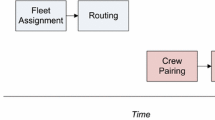Abstract
We present a general modeling approach to crew rostering and its application to computer-assisted generation of rotation-based rosters (or rotas) at the London Underground. Our goals were flexibility, speed, and optimality, and our approach is unique in that it achieves all three. Flexibility was important because requirements at the Underground are evolving and because specialized approaches in the literature did not meet our flexibility-implied need to use standard solvers. We decompose crew rostering into stages that can each be solved with a standard commercial MILP solver. Using a 167 MHz Sun UltraSparc 1 and CPLEX 4.0 MILP solver, we obtained high-quality rosters in runtimes ranging from a few seconds to a few minutes within 2% of optimality. Input data were takes from different depots with crew sizes ranging from 30–150 drivers, i.e., with number of duties ranging from about 200–1000. Using an argument based on decomposition and aggregation, we prove the optimality of our approach for the overall crew rostering problem.
Similar content being viewed by others
References
Bixby, R. (2002). “Solving Real-World Linear Programs: A Decade and More of Progress.” Operations Research 50(1), 3-15.
Caprara, A., M. Fischetti, P. Toth, and D. Vigo. (1998). “Modeling and Solving the Crew Rostering Problem.” Operations Research 46(6), 820-830.
Emden-Weinert, T., H. Kotas, and U. Speer. (2001). “DISSY-A Driver Scheduling System for Public Transport.” Version 1.11, downloaded on July 11, 2002 from http://people.freenet.de/ Emden-Weinert/DISSY/DISSY-Whitepaper.html
Ernst, A.T., H. Jiang, M. Krishnamoorthy, H. Nott, and D. Sier. (2000). “An Integrated Optimization Model for Train Crew Management.” Annals of Operations Research, to appear.
Ernst, A.T., H. Jiang, M. Krishnamoorthy, and D. Sier. (2001). “Staff Scheduling and Rostering: A Review of Applications, Methods and Models.” European Journal of Operational Research, to appear.
Jain, V. and I.E. Grossman. (2001). “Algorithms for Hybrid MILP/CP Models for a Class of Optimization Problems.” INFORMS Journal on Computing 13(4), 258-276.
Author information
Authors and Affiliations
Rights and permissions
About this article
Cite this article
Sodhi, M.S., Norris, S. A Flexible, Fast, and Optimal Modeling Approach Applied to Crew Rostering at London Underground. Annals of Operations Research 127, 259–281 (2004). https://doi.org/10.1023/B:ANOR.0000019092.76669.a1
Issue Date:
DOI: https://doi.org/10.1023/B:ANOR.0000019092.76669.a1




